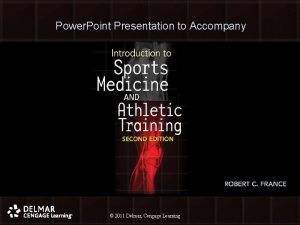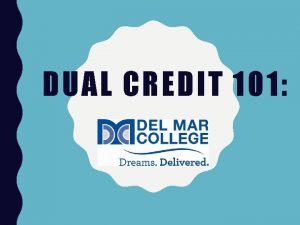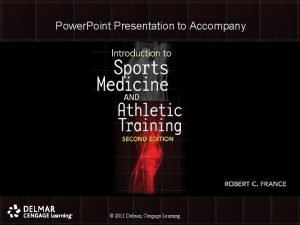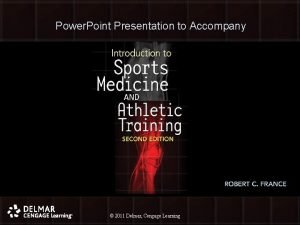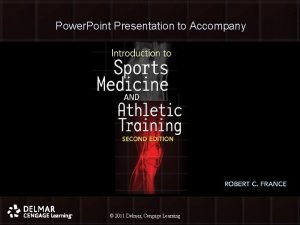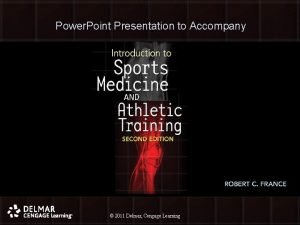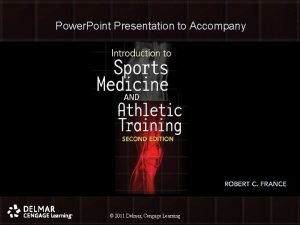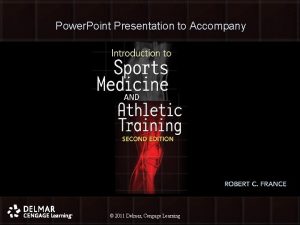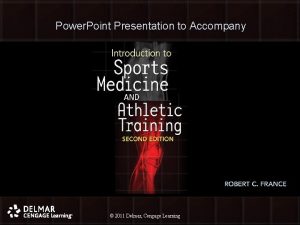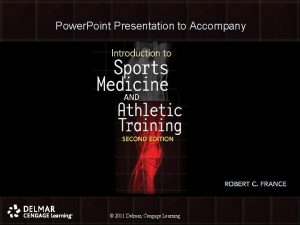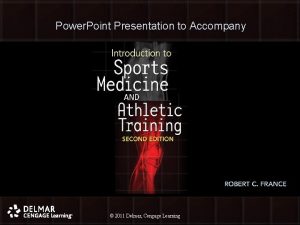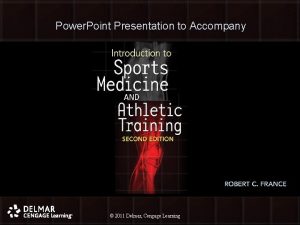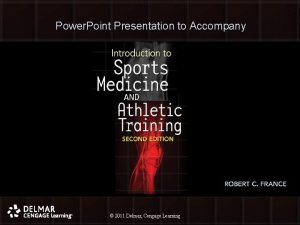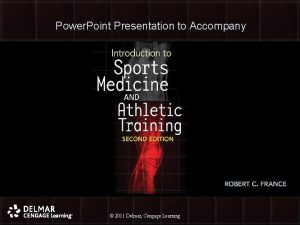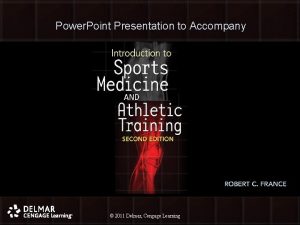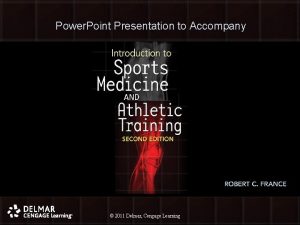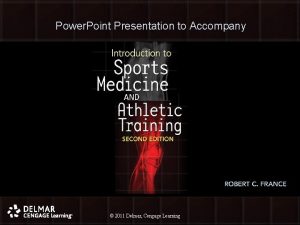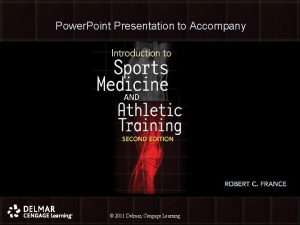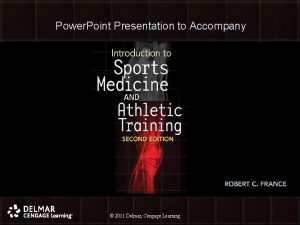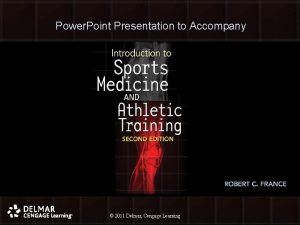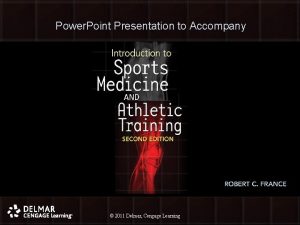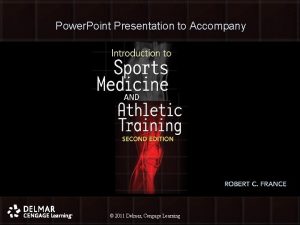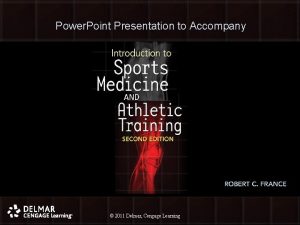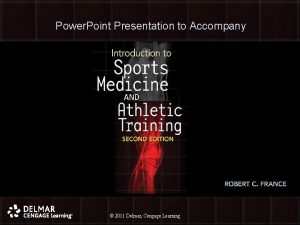Power Point Presentation to Accompany 2011 Delmar Cengage
























- Slides: 24

Power. Point Presentation to Accompany © 2011 Delmar, Cengage Learning © 2010 Delmar, Cengage Learning

Chapter 8 Nutrition and the Athlete © 2011 Delmar, Cengage Learning © 2010 Delmar, Cengage Learning 2

Objectives • Upon completion of this chapter, you should be able to: – Explain how good nutritional habits lead to increased athletic performance and good health – Discuss the relationship of energy to food – Describe the seven food components and their importance to nutrition © 2011 Delmar, Cengage Learning © 2010 Delmar, Cengage Learning 33

Objectives (cont’d. ) • Upon completion of this chapter, you should be able to (cont’d. ): – Explain the importance of vitamins and minerals to a sound diet – Compare and contrast the four food pyramids outlined in the chapter – Define nutritional quackery – Discuss proper weight control © 2011 Delmar, Cengage Learning © 2010 Delmar, Cengage Learning 44

Objectives (cont’d. ) • Upon completion of this chapter, you should be able to (cont’d. ): – Discuss the underlying reasons for disordered eating © 2011 Delmar, Cengage Learning © 2010 Delmar, Cengage Learning 55

Nutrition • Process by which a living organism assimilates food and uses it for growth and for replacement of tissues • Field of science or study that deals with food and nourishment • Proper nutrition can reduce likelihood of injury and increase performance © 2011 Delmar, Cengage Learning © 2010 Delmar, Cengage Learning 66

Energy • Power used to do work or to produce heat or light • Cannot be created or destroyed, but it can be changed from one form to another – Solar energy – Photosynthesis © 2011 Delmar, Cengage Learning © 2010 Delmar, Cengage Learning 77

Energy (cont’d. ) • Needed: – To maintain body functions – For active movement – For growth and repair • In nutrition, energy is measured as calories © 2011 Delmar, Cengage Learning © 2010 Delmar, Cengage Learning 88

Food Components • Carbohydrates – Primary source of fuel (glucose) for energy • Simple carbohydrates (sugars) • Complex carbohydrates (starches) • Proteins – Body’s main structural elements – Found in every cell and tissue © 2011 Delmar, Cengage Learning © 2010 Delmar, Cengage Learning 99

Food Components (cont’d. ) • Fats – Dietary fat • • Carrier of fat-soluble vitamins Provides certain essential fatty acids Important source of energy Used interchangeably with protein and carbohydrates – Fatty acids • Saturated, monounsaturated, polyunsaturated, and trans fatty acids © 2011 Delmar, Cengage Learning © 2010 Delmar, Cengage Learning 1010

Food Components (cont’d. ) • Vitamins – Complex organic substances the body needs in small amounts • Measured in milligrams (mg) or micrograms (mcg) – Fat-soluble • Meats, liver, dairy products, eggs, and leafy green vegetables – Water-soluble • Whole grain cereals, leafy green vegetables, fruits, and legumes © 2011 Delmar, Cengage Learning © 2010 Delmar, Cengage Learning 1111

Food Components (cont’d. ) • Minerals – Inorganic substances – Participate in biochemical and physiological processes necessary for proper growth, development, and health © 2011 Delmar, Cengage Learning © 2010 Delmar, Cengage Learning 1212

Food Components (cont’d. ) • Water – Most important, often neglected, nutrient – Kidneys play an important role in conserving and excreting water – On average, the body will lose approximately seven glasses of water each day • To maintain proper hydration, drink six to eight glasses of fluids each day, more when active © 2011 Delmar, Cengage Learning © 2010 Delmar, Cengage Learning 1313

Food Components (cont’d. ) • Sports drinks – Contain sugar, minerals (e. g. , potassium and sodium), and water – Can help with long, hard workouts exceeding one hour © 2011 Delmar, Cengage Learning © 2010 Delmar, Cengage Learning 1414

Food Components (cont’d. ) • Dietary fiber – Indigestible component of plant material – Keeps the digestive tract running smoothly • Soluble fiber • Insoluble fiber © 2011 Delmar, Cengage Learning © 2010 Delmar, Cengage Learning 1515

Daily Values • Helps consumers use food label information in diet planning • Daily Reference Values are based on the number of calories consumed per day – 2, 000 calories has been established as the reference © 2011 Delmar, Cengage Learning © 2010 Delmar, Cengage Learning 1616

Food Guide Pyramid • Six groups in the USDA food pyramid: – Breads, cereals, rice, and pasta – Vegetables – Fruit – Meat, poultry, and fish – Milk products – Fats, oils, and sweets © 2011 Delmar, Cengage Learning © 2010 Delmar, Cengage Learning 1717

Nutritional Quackery • Many seek out “magic” supplements to give them an edge • Nutritional quackery is successful because it plays on emotions and misinformation • Many supplements are developed and sold without supporting scientific research © 2011 Delmar, Cengage Learning © 2010 Delmar, Cengage Learning 1818

Making the Weight • Proper weight management enhances good health and athletic performance – Gaining weight • Increase lean body mass – Losing weight • Restricted calorie intake • Exercise • Both © 2011 Delmar, Cengage Learning © 2010 Delmar, Cengage Learning 1919

Disordered Eating • Extreme expressions of food and weight issues experienced by many individuals – Include: • Anorexia nervosa and manorexia • Bulimia nervosa • Binge eating – Female athlete triad • Disordered eating, amenorrhea, and osteoporosis © 2011 Delmar, Cengage Learning © 2010 Delmar, Cengage Learning 2020

Special Diets • Pregame meals limit protein intake and concentrate on carbohydrates – Example: • 1 to 2 cups pasta with 1 1/2 cups tomato meat sauce • Bread • Milk (low-fat or skim) • Orange juice • Oatmeal raisin cookie • Water © 2011 Delmar, Cengage Learning © 2010 Delmar, Cengage Learning 2121

Calculating “Ideal’ Weight for Athletes • Body mass index (BMI) is a reliable indicator of total body fat • Limitations: – May overestimate body fat in athletes and others who have a muscular build – May underestimate body fat in older persons and others who have lost muscle mass © 2011 Delmar, Cengage Learning © 2010 Delmar, Cengage Learning 2222

Calculating “Ideal’ Weight for Athletes (cont’d. ) • To determine BMI: – Divide weight in pounds by height in inches – Divide again by height in inches – Multiply by 703 © 2011 Delmar, Cengage Learning © 2010 Delmar, Cengage Learning 2323

Conclusion • Proper nutrition reduces the likelihood of injury and allows higher performance levels • Disordered eating is an extreme expression of food and weight issues • As athletes become aware of the nutritional components of their diet, they face fewer problems © 2011 Delmar, Cengage Learning © 2010 Delmar, Cengage Learning 2424
 2009 delmar cengage learning
2009 delmar cengage learning 2009 delmar cengage learning
2009 delmar cengage learning Chapter 1 introduction to medical terminology answer key
Chapter 1 introduction to medical terminology answer key Graphing tpr
Graphing tpr 2009 delmar cengage learning
2009 delmar cengage learning Chapter 13 medical math assignment sheet cengage learning
Chapter 13 medical math assignment sheet cengage learning 2009 delmar cengage learning
2009 delmar cengage learning Delmar cengage learning instructor resources
Delmar cengage learning instructor resources Hebrews 6:9-12 sermon
Hebrews 6:9-12 sermon Accompany chapter 1
Accompany chapter 1 Lymphatics that accompany the cephalic vein drain into the
Lymphatics that accompany the cephalic vein drain into the Printers create objects such as prototypes and models.
Printers create objects such as prototypes and models. Presentation topics for students in hindi
Presentation topics for students in hindi Power point presentation design west vancouver
Power point presentation design west vancouver Delmar isotonic
Delmar isotonic Delmar tsi
Delmar tsi Delmar cargo
Delmar cargo Thomson delmar learning
Thomson delmar learning Delmar larsen
Delmar larsen Draw power triangle
Draw power triangle Informsu
Informsu Point point power
Point point power The human respiratory system chapter 7 handout
The human respiratory system chapter 7 handout Cengage differential equations
Cengage differential equations Century 21 bank
Century 21 bank














